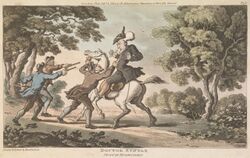Villain (nonfiction): Difference between revisions
Jump to navigation
Jump to search
(Created page with "A '''villain''' (also known as the "antagonist," "baddie", "bad guy", "heavy" or "black hat") is an "evil" character in a story, whether a historical narrative or, especially,...") |
No edit summary |
||
| Line 1: | Line 1: | ||
A '''villain''' (also known as the "antagonist," "baddie", "bad guy", "heavy" or "black hat") is an "evil" character in a story, whether a historical narrative or, especially, a work of fiction. | [[File:Dr._Syntax_stopped_by_highwaymen_Engraving.jpg|thumb|250px|Doctor Syntax and Highwaymen, 1813 - Engraving by Thomas Rowlandson. "Doctor Syntax" – a popular literary character of the early nineteenth century – on horseback, stopped by three robbers armed with pistols.]]A '''villain''' (also known as the "antagonist," "baddie", "bad guy", "heavy" or "black hat") is an "evil" character in a story, whether a historical narrative or, especially, a work of fiction. | ||
== Description == | == Description == | ||
Revision as of 11:18, 5 June 2016
A villain (also known as the "antagonist," "baddie", "bad guy", "heavy" or "black hat") is an "evil" character in a story, whether a historical narrative or, especially, a work of fiction.
Description
The villain usually is the antagonist (though can be the protagonist), the character who tends to have a negative effect on other characters.
A female villain is occasionally called a villainess (often to differentiate her from a male villain).
Random House Unabridged Dictionary defines villain as:
A cruelly malicious person who is involved in or devoted to wickedness or crime; scoundrel; or a character in a play, novel, or the like, who constitutes an important evil agency in the plot".
